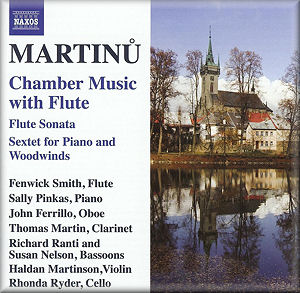 |
 |
|


alternatively
CD: MDT
AmazonUK
AmazonUS
Sound
Samples & Downloads
|
Bohuslav MARTINŮ
(1890-1959)
Chamber Music with Flute
Sonata for flute, violin and piano H.254 (1936) [15:57]
Sonata for flute and piano H.306 (1945) [18:27]
Sextet for piano and woodwinds H.174 (1929) [15:20]
Trio for flute, cello and piano H.300 (1944) [19:06]
 Fenwick Smith (flute); Sally Pinkas (piano); John Ferrillo (oboe);
Thomas Martin (clarinet): Richard Ranti and Suzanne Nelson (bassoons);
Haldan Martinson (violin); Rhonda Ryder (cello)
Fenwick Smith (flute); Sally Pinkas (piano); John Ferrillo (oboe);
Thomas Martin (clarinet): Richard Ranti and Suzanne Nelson (bassoons);
Haldan Martinson (violin); Rhonda Ryder (cello)
rec. September 2002 (Sonata for flute and piano) and March 2005
(Sonata for flute, violin and piano); March 2004 (Sextet) and March
2007 (Trio) The Sonic Temple, Roslindale, Massachusetts and Jordan
Hall, New England Conservatory
 NAXOS 8.572467 [68:50]
NAXOS 8.572467 [68:50] 
|
|
|
It’s rather unusual, and therefore welcome, to find a
disc devoted so squarely to Martinů’s chamber works
involving the flute Normally one finds that companies prefer
a more across the board approach, mixing the flute works with,
say, the Madrigal sonatas or with La Revue de Cuisine
or with the Nonet. Or one finds a presentation of the Czech
composer’s works in the context of near contemporaries,
such as Poulenc and Prokofiev, in an exploration specifically
of the powerfully attractive Flute Sonata. So, it’s pleasing
to find a disc such as this, which has the confidence to focus
closely.
The Sonata for flute, violin and piano H.254 was written in
1936 and dedicated to the wife of Marcel Moÿse, whose husband,
Marcel, gave the premiere in a ‘family affair’ performance
with Louis Moÿse and Blanche Moÿse Honegger. Interestingly
a 1938 performance by this august trio has survived and was
issued on a Martinů Society promotional CD in 2005. The
present Naxos performance is good but sounds somewhat ‘sewing
machine’ in places, especially in comparison with the
more specialised Gallic charm of the older trio’s performance.
The slow movement, though, has tenderness and a real sense of
affection and it seems pedantic, given the finesse of the playing,
to note that the Moÿse performance had a more aloofly yielding
introspection in this movement. Where I do feel a decided superiority
in the older performance is in the finale, where the Naxos trio
make rather too much of a contrast when moving into the B section;
it sounds much better when, as with the Moÿse, you slide
into it without too much fuss.
Probably the best known of the quartet in this selection is
the Flute Sonata. Fenwick Smith and Sally Pinkas are assured
guides but take a decidedly less incisive approach than, say,
Jean-Pierre Rampal and John Steele Ritter [SK53106, in a very
mixed mainly vocal recital by Kathleen Battle]. I prefer Ritter’s
more arresting pianism and the greater sense of characterisation
generated by the Rampal-Ritter duo generally. Perhaps the Naxos
duo honour the finale’s Allegro poco moderato injunction
just a touch better in the slightly steadier tempo they adopt
- but Rampal does shape the birdsong more inventively in any
case.
The Sextet for piano and winds is the earliest work here, dating
from 1929. It’s cast in five brief movements, and utilises
baroque punctuation adeptly. There’s a beautiful Adagio,
and a Blues in which the bassoon imitates a night club saxophone;
then a vivacious finale. This Sextet reminds us of La Revue
de Cuisine, especially in its use of the vampy and Stride-patterned
piano contributions and the infectious liveliness of the writing.
The Trio for flute, cello and piano H.300 (1944) is an attractive
work, and sports one truly memorable idea - the flute recitative
over accompanying cello pizzicato figures. It’s a fluid
and leisurely piece, in all respects, not from the top drawer
but marked by consummate craftsmanship.
Well recorded over a period of years in two locations, these
performances have been artfully brought together. None is a
front-ranker, quite, but all are highly personable.
Jonathan Woolf
|
|

